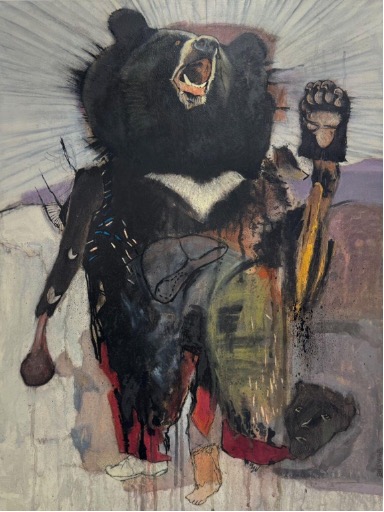by Shelby Hammack
On January 14, 2025, Valdosta State University’s Dedo Maranville Fine Arts Gallery held the opening reception for the 37th annual Valdosta National exhibition. Curated by the gallery director, Mark Errol, and juried by Professor of Art at Columbus State University, Michael McFalls, the 2025 Valdosta National presents a wide variety in subject matter, medium, and style.
Though not cohesive in medium and subject matter, the collection of works is unified through the intentional manner in which it is displayed. In an interview with Errol, he states that in producing the Call for Entry, he, along with McFalls, sought out work that was “outside the traditional realm” of the Valdosta area;1 Errol adds that part of the selection process reflected the desire to push boundaries within the gallery.
Upon first entering the space, the open floor plan allows the viewer’s focus to shift to the walls, which are thoughtfully and minimally decorated with a variety of artists’ works. The two-dimensional mediums in the exhibition include graphite, color pencil, oil, acrylic, watercolor, ink, and photography; sculptural and textile mediums featured in the exhibition include ceramics, fabrics and thread, miniature scale models, and found objects. The wide variety of mediums are derived from a compilation of artists in varying locations in North America.

Among the most impressive of the collection, both through demonstration of technical skill and understanding of media and composition, is Terry Brewer’s expressionist Cave Painting #9: Himalayan Black Bear, mixed media on panel. Inspired by numerous treks through the Himalayas2, the focal point of Stout’s work lies in a realistic portrait of a Himalayan Black Bear painted with oil; radiating from behind the bear’s head is a starburst explosion of muted blues and greys. Other fragments of imagery in the artwork include a bear’s paw, a linear drawing of a human liver, and crudely rendered human features, such as a face and foot, which lend to the cave-like drawing narrative. The work is littered with different media, including what may be interpreted as oil paint, charcoal, ink, chalk pastel, and oil pastel, each varying in color, value, and intensity. Rather than leaving the work seemingly unfinished, the raw wooden edge of the panel speaks to the natural and somewhat jarring subject matter of the piece.
On the opposing end of the spectrum, the least impressive of the selection are Joshua Brinlee’s digital collages, Self-Portrait as Churned and Self-Portrait as Boil. Though I can see the artist’s homage to Arcimbaldo, the Artificial-Intelligence generated imagery seem counter-intuitive, and to lack ambition. As Artificial-Intelligence continues to threaten the occupation and livelihood of artists, Brinlee’s works may be considered traitorous to the art community. Despite this perspective, it is worth noting that the artist is forward in their use of Artificial-Intelligence, claiming to use it as a tool in their artistic process3. Along with this, the Abstract Expressionist artworks are cohesive in style, composition, and use of vivid color, such as yellow and red.

Awarded first place is Jason Stout’s expressionist painting, Sunroom for the End of the World, oil on canvas. The piece features the interior view of a sunroom painted in a majorly secondary color scheme; the large naked windows of the room reveal warm, blooming clouds that engulf the horizon, which are suggested to be the aftermath of atomic warfare. While a reason for the selection of awards is not explicitly given in the juror’s statement, McFall claims, “each piece earned its place through both its individual merit and contribution to the collective dialogue.”4 Although Stout’s piece would not have been my selection for Best in Show, the painting’s vibrant and clean application of color is commendable in the least; the title appropriately given to the painting not only suits the work, but enhances the overall nature and narrative of the imagery.

Each artwork included in the 2025 Valdosta National portrays a high level of understanding in media, composition, and intent. With the preconceived theme in the selection of this exhibition, the artworks displayed in the gallery are successful in pushing boundaries, whether it be emotionally, visually, or physically through use of media.